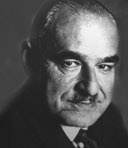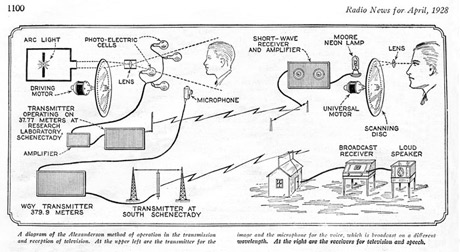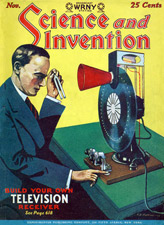 A Scottish engineer, John Logie Baird was the inventor of the first publicly demonstrated and public television in the whole world. He was also the inventor of the first color, electronic television tube. His significant place in the invention of the television is secured by way of his achievements in displaying working television broadcasts. Baird’s television system was in the end displaced by a purely electronic television system, his having been an electromechanical one.
A Scottish engineer, John Logie Baird was the inventor of the first publicly demonstrated and public television in the whole world. He was also the inventor of the first color, electronic television tube. His significant place in the invention of the television is secured by way of his achievements in displaying working television broadcasts. Baird’s television system was in the end displaced by a purely electronic television system, his having been an electromechanical one.
Baird was a Scotsman, born in Helensburgh on August 13, 1888. He went on to be educated at Larchfield Academy, which was also in Helensburgh. His studies at institutes of higher learning took place at the Glasgow and West of Scotland Technical College and then later on at the University of Glasgow. Interestingly, he never returned to his university to finish his course work after World War I interrupted his studies.
Early Influence
 Arthur Korn was a German-born, Jewish inventor, and he both invented and crafted the first circuits for signal conditioning that were for image transmission. Korn’s circuits permitted him to send pictures either by wireless or by telephone between oceans and countries. His circuit worked even without the advantage of electronic amplification. Baird was a direct beneficiary of this technology of Korn’s.
Arthur Korn was a German-born, Jewish inventor, and he both invented and crafted the first circuits for signal conditioning that were for image transmission. Korn’s circuits permitted him to send pictures either by wireless or by telephone between oceans and countries. His circuit worked even without the advantage of electronic amplification. Baird was a direct beneficiary of this technology of Korn’s.
The First Television
Baird’s success was founded upon being able to create the first moving, live, grayscale television image that came from reflected light. He was successful since he bettered the signal conditioning from both the video amplifier and the photocell. On the back of this success, the Scotsman, in the early 1920s, began to rent a workshop in Hastings, which he would use for his experimentations. After getting a massive electric shock and consequently being evicted by his landlord, Baird took his experiments to a workshop in London’s Soho neighborhood.
 On October 2, 1925, Baird made a breakthrough by succeeding at transmitting the very first grayscale, television image. After this success, Baird looked for publicity by paying a visit to the offices of the Daily Express newspaper, yet the editor at the time thought him to be mad and warned his staff to be wary of him. A few months later in January of 1926, Baird demonstrated his transmission success to both a reporter from the Times newspaper as well as members of the Royal Institution. More demonstrations followed thereafter: In July of 1928, he demonstrated the very first color transmission in the world, and in 1932, he demonstrated the first ultra-short wave transmissions in Britain.
On October 2, 1925, Baird made a breakthrough by succeeding at transmitting the very first grayscale, television image. After this success, Baird looked for publicity by paying a visit to the offices of the Daily Express newspaper, yet the editor at the time thought him to be mad and warned his staff to be wary of him. A few months later in January of 1926, Baird demonstrated his transmission success to both a reporter from the Times newspaper as well as members of the Royal Institution. More demonstrations followed thereafter: In July of 1928, he demonstrated the very first color transmission in the world, and in 1932, he demonstrated the first ultra-short wave transmissions in Britain.

Other Innovations
 In 1927, the Scotsman had already transmitted a long-distance television signal between Glasgow and London. This was the precursor to him establishing his own company, the Baird Television Development Company Ltd., which holds the distinction of producing the first transmission across the Atlantic from London to New York in 1928. It also made the first television program for the BBC. Baird’s television systems were used by the BBC until 1937, when they decided to switch to an electronic television system that was created by EMI-Marconi. Even though mechanical television systems had been relegated due to the more popular electronic systems, Baird still contributed to the newer medium. He both demonstrated and patented a system of 3-D television that had a definition of 500 lines in 1941, and he also performed the world’s first demonstration of a television display that was completely electronic in 1944.
In 1927, the Scotsman had already transmitted a long-distance television signal between Glasgow and London. This was the precursor to him establishing his own company, the Baird Television Development Company Ltd., which holds the distinction of producing the first transmission across the Atlantic from London to New York in 1928. It also made the first television program for the BBC. Baird’s television systems were used by the BBC until 1937, when they decided to switch to an electronic television system that was created by EMI-Marconi. Even though mechanical television systems had been relegated due to the more popular electronic systems, Baird still contributed to the newer medium. He both demonstrated and patented a system of 3-D television that had a definition of 500 lines in 1941, and he also performed the world’s first demonstration of a television display that was completely electronic in 1944.
Though the Scotsman’s contributions were primarily to the television industry, he dabbled elsewhere. In his 20s, he attempted to make diamonds by heating up graphite, yet that resulted in the shorting out of Glasgow’s supply of electricity. Baird finally died on June 14, 1946, the casualty of a stroke that he endured a few months earlier. Today, Baird is buried in Helensburgh Cemetery along with his wife and parents.
Further Resources
To learn more about the Scotsman, check out the following links.
- Biography of John Logie Baird: A brief history about the Scotsman�۪s career and life.
- Achievements of John Logie Baird: A detailed look at the accomplishments of Baird.
- Television and Baird: A site dedicated to exploring Baird’s contributions to television.
- John Logie Baird FAQ: An FAQ committed to answering basic questions about this pioneer.
- John Logie Baird Resource Web Page: A web page dedicated to providing a wealth of information and links on Baird.
- John Logie Baird: Inventor and Scientist: A web page that focuses on Baird’s career.
- Baird Timeline: A timeline of important occurrences in the Scotsman’s career and life.
- Scientist Hall of Fame: Website that boasts of Baird’s achievements in television.
- Biography on Baird’s Life: Web page that discusses revelations about Baird from a biography of him.

